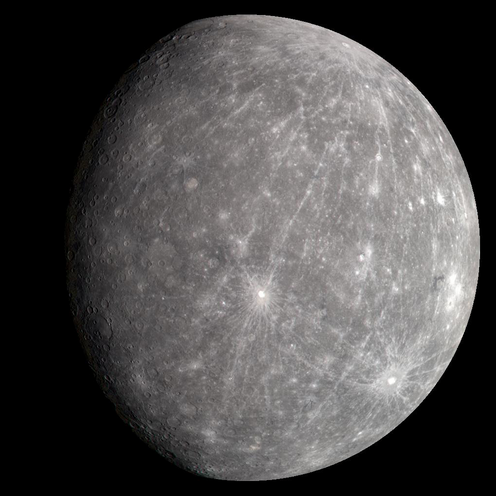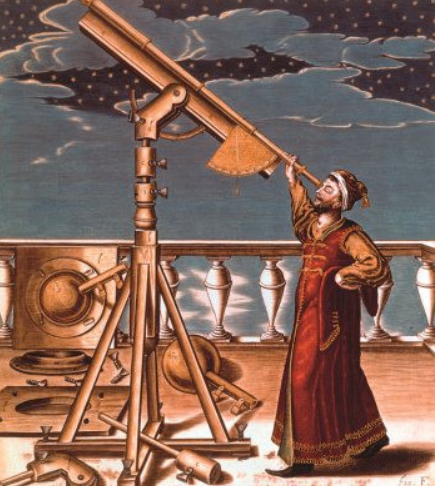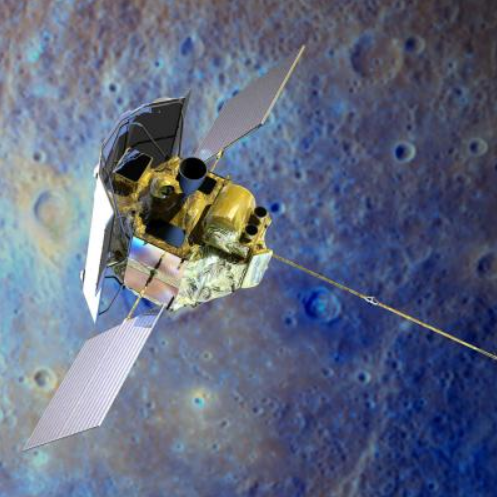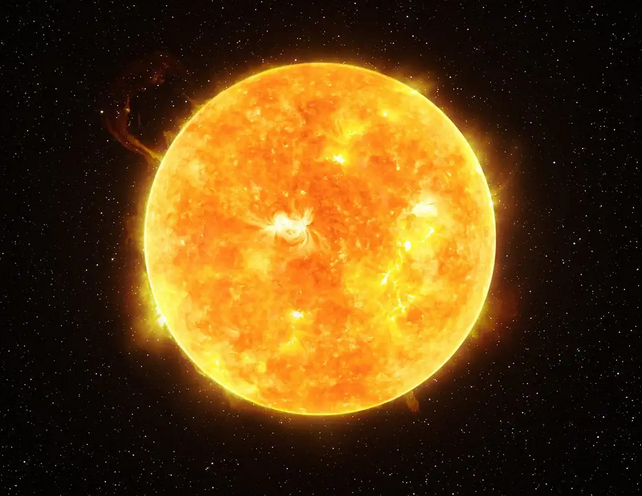We will learn more about Mercury in this post and some of the impressive statistics that surround this body in our solar system. So if you want to find out the answers to Mercury’s orbital period read on.
What Is Mercury?
Mercury is a small planet in our solar system which is located closer to the Sun than any of the others. It is the smallest of all the planets of our solar system and is in fact only just a little larger than Earth’s Moon. It is so close to the Sun that from its surface our solar system’s only star would appear three times larger than it does to our own eyes.

It is a terrestrial planet which means like earth it has a rocky surface. This surface is heavily cratered and if we could stand upon it we would be able to see the Sun rise briefly, set, and rise again from some parts of the planet’s surface. This happens in reverse at sunset and is caused by the planet’s elliptical orbit around the Sun.
How Close is Mercury to Earth?
It is the closest planet to the sun and is separated from Earth only by Venus. Depending on their position in their respective orbits Mercury is roughly 48 million miles away from the Earth when they are at their closest.
How Close is Mercury to the Sun?
Mercury’s distance from the Sun depends on where the planet is in its rotation. When Mercury is at its closest it is 29 million miles away from the Sun and at its furthest it is 43 million miles away. It takes a little over 3 minutes for the light of the Sun to reach the surface of Mercury. In context it takes just over 8 minutes for the same late to reach the surface of the Earth.
Mercury’s Structure
Internal Structure
Mercury appears to consist of a solid silicate crust and mantle which covers a solid, iron sulfide outer core layer. There is also thought to be a deeper liquid core layer, and finally a solid inner core. It is extremely dense and in fact is the second most dense planet in our solar system.
Surface
Mercury’s surface is similar to the Moon’s in appearance with numerous craters. This indicates vast amounts of bombardment by comets and asteroids during and shortly after its formation 4.6 billion years ago. There was also a later era of bombardment that came to an end 3.8 billion years ago.
The planet’s mantle indicates that Mercury went through a magma ocean phase at some point in its history. This likely led to differing layers of crystalized minerals.
The surface temperatures on Mercury range from -280 to 800 degrees Fahrenheit depending on the region and rotation of the planet.
Does Mercury Have Moons?
Mercury is one of two planets in our solar system that has no natural satellites at all which is something that interests astronomers. There are three main ways that a planet gets a moon and early in the history of our solar system conditions were such that it is odd that Mercury did not get at least one.
Prevailing thinking suggests that moons can be “captured” into orbit as they drift by the planet. This is likely what happened to Phobos and Deimos (near Mars). Alternatively, an object may have smashed into the planet expelling fragments out beyond the planet’s atmosphere which eventually came together into a moon. Our own Moon is thought to have been created in this manner. Finally the moons might arise from the general accretion of matter. This is how the planets themselves were formed.
History of the Observation of Mercury
The earliest known observations of Mercury to be recorded come from the MUL.APIN tablets. Likely made by an Assyrian astronomer these observations were made around the 14th century BC.
The cuneiform name used to designate Mercury on the MUL.APIN tablets translates to “the jumping planet.” Babylonian records regarding the observation of Mercury date back to the 1st millennium BC. To the Babylonians the planet was known as Nabu, named for the messenger to the gods from their mythology.
Telescopic Exploration
Mercury’s presence was already well established and its status as a planet was understood but with the advent of powerful telescopes astronomers such as Thomas Harriot and Galileo were able to take a closer look in 1610.

In 1612 German astronomer Simon Marius observed that the planet’s apparent brightness varied depending on its orbital position. This observation led Marius to conclude that Mercury, like Venus and the Moon, has phases.
It was in 1631, that Pierre Gassendi made the first telescopic observations tracking the transit of a planet across the Sun. He was able to do this thanks to Johannes Kepler’s predictions of Mercury’s transit. Mercury and its neighbor Venus every few centuries offer up a rare astronomical event. Known as an occultation, it is an event that sees one planet passing in front of the other. This was last seen on May 28th 1737 and will not occur again until December 3rd 2133 (something to mention to the grandkids).
Space Probes
Mercury’s proximity to the Sun makes it a challenging prospect for exploration even by probes but this has not prevented the pioneers of space. It was NASA’s Mariner 10 mission which launched in 1974 which was the first to get close to Mercury. The mission used a gravitational slingshot from Venus to reach Mercury, the first of its kind in space travel within our solar system.
Mariner 10 was only able to get images of one side of Mercury as the same edge was lit with every close pass made by the probe. This means it mapped less than 45% of the planet’s surface despite getting within 203 miles of the surface.
It would be several years until NASA sent another probe this time as part of the MESSENGER mission launched in 2004. Its first flyby occurred on January 14th 2008 with subsequent runs occurring over the next 20 months. It would ultimately capture mapping for the rest of the planet that Mariner 10 was unable to map.

The European Space Agency and the Japanese Space Agency have worked together to develop and launch a mission called BepiColombo. This is intended to orbit Mercury with two probes, with the intent to map the planet and study its magnetosphere. This was launched on October 20th 2018 and is expected to reach Mercury in 2025.
What Is the Sun?
The orb that is visible in our daylight sky which we know as the sun is in fact a star. This star is classified as a yellow dwarf and is central to our solar system. Earth and the other planets of our solar system orbit this vast star. In fact it is our own planet’s rotation and orbit which creates the appearance of the sun moving across our sky. It itself is stationary as we revolve around it.

How Big Is the Sun?
The sun on a clear day is visible from the earth and in fact we should never stare directly at it. This is despite it being 93 million miles away so just how big is this giant orange orb? Scientists estimate that the sun has a radius of roughly 435,000 miles.
This may sound massive but there are many known stars which are much larger. In comparison to our planet however the son is roughly 330,000 times the mass of earth and we could fit our planet into the sun 1.3 million times.
What Holds the Sun Together?
The sun because it is a star is actually a huge ball of gas which is held together by its own internal gravitational forces. It is made up of several regions which include in order from the center out:
- Core
- Radioactive zone
- Convection zone
- Photosphere
- Chromosphere
- Transition zone
- Corona
Once material exits the corona of the sun at supersonic speeds, it becomes what is known as a solar wind. This solar wind forms a huge magnetic bubble of sorts around the sun which is known as the heliosphere. It is this heliosphere that extends beyond the orbit of all the planets in our solar system. Essentially our planet as well as all others in the solar system are held within the sun’s atmosphere.
How Long Does Mercury Take to Go Around the Sun?
The smallest planet in our solar system and located so close to the Sun you may not be surprised that Mercury has a short orbital period. It takes far less time than our own planet Earth to complete an orbit of the Sun in fact it takes only 88 Earth Days.
Final Thoughts
Mercury’s distance from the Sun varies depending on where it is in its orbit, but it is generally very close to this massive star. Its orbital period in fact is around 4 times shorter than that of our own planet Earth. The planet’s own rotation is actually very slow so although a year on Mercury is 88 Earth days the planet’s own rotation takes 59 Earth days.
